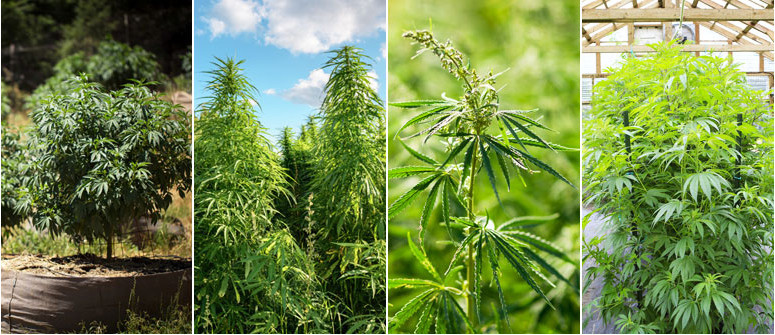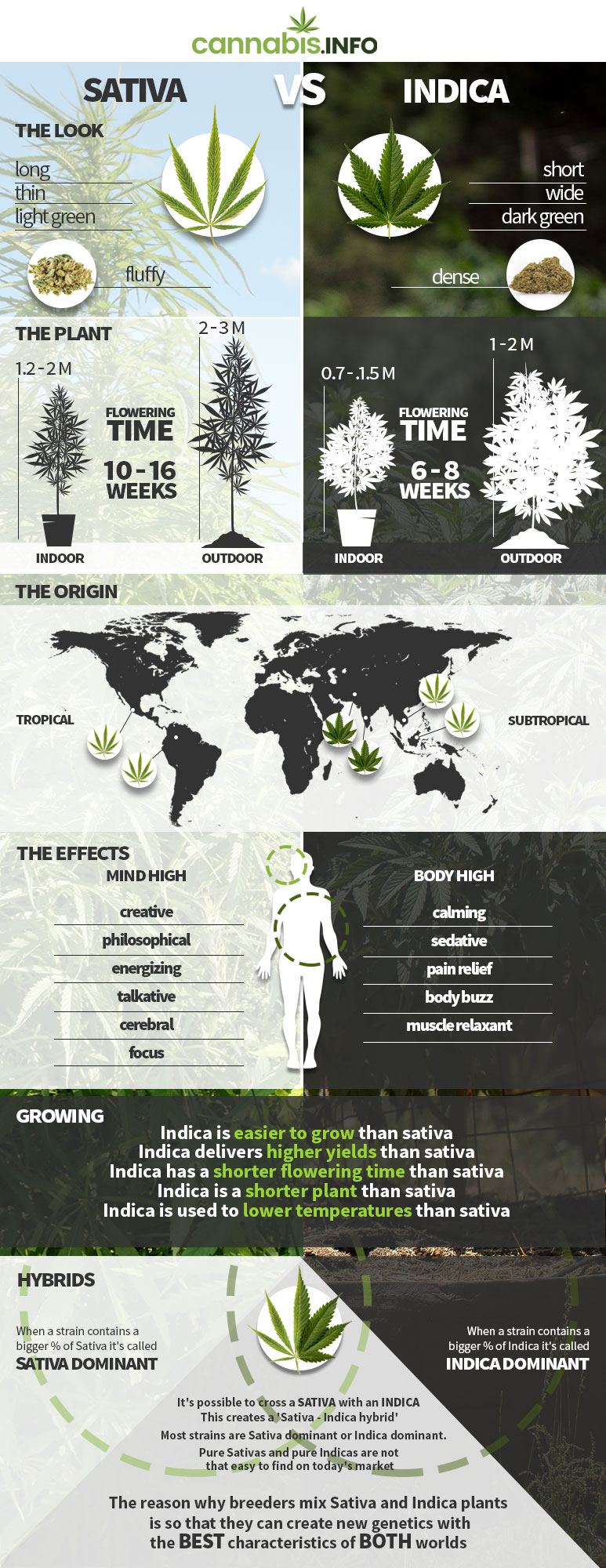Indica vs Sativa: A Guide to Types of Cannabis Explained

Find out at CannaConnection about the differences between sativa, indica, ruderalis and hybrid cannabis plants. Effect, appearance, where they come from etc.
Sativa: A Guide to Types of Cannabis is an essential read for those looking to dive deeper into the world of cannabis plants and their unique characteristics. In this comprehensive guide, we will investigate the contrasting qualities of indica and sativa strains, as well as hybrid varieties that blend traits from both parent plants.
We'll also discuss how THC and CBD levels can affect a strain's psychoactive effects and medicinal properties. Additionally, you'll learn about terpenes – the aromatic compounds responsible for each strain's distinct aroma – and how they contribute to a plant's overall cannabinoid profile.
Furthermore, we delve into individual tolerance levels when consuming cannabis products, ensuring users have a better understanding of their own reactions to different strains. Finally, we offer guidance on finding the right strain tailored specifically for your needs – whether it be recreational enjoyment or therapeutic relief.
Table of Contents:
- What is Sativa?
- What is Indica?
- What are Hybrids?
- How Do THC and CBD Levels Affect Cannabis Strains?
- What Role Do Terpenes Play in Cannabis Strains?
- How Can Individual Tolerance Impact Cannabis Effects?
- How Can Consumers Find the Right Strain for Them?
- Frequently Asked Questions Indica vs Sativa: a Guide to Types of Cannabis
- Conclusion
What is Sativa?
Sativa is a type of cannabis strain that is known for its uplifting and energetic effects. Originating from equatorial regions such as Central America, Africa, and Southeast Asia, these strains have adapted to their environments by growing tall with thin leaves. This allows them to better capture sunlight in dense vegetation.
The Effects of Sativa Strains
Sativas are often characterized by their cerebral high, which can lead to increased creativity, focus, and sociability. These strains are ideal for daytime use or when engaging in activities requiring mental stimulation. Some common effects associated with sativas include:
- Euphoria
- Increase in energy levels
- Mental clarity and focus
- Enhanced sensory experiences (sight, sound, taste)
- Mood elevation or alleviation of depression symptoms
Cultivating Sativa Strains at Home
If you're interested in cultivating your own sativa plants at home, growing cannabis indoors is an excellent option due to the controlled environment it provides. However, keep in mind that sativas tend to grow taller than indica varieties; therefore adequate space must be available for optimal growth.
Tips for Growing Sativas:
- Select suitable genetics: Choose seeds specifically bred for indoor cultivation if possible. lCreate ample vertical space: Ensure there's enough room above your plants so they don't outgrow their area.
- Adequate lighting: Since sativas thrive in sunlight, provide a strong light source to mimic natural conditions.
- Pruning and training: Techniques such as low-stress training (LST) can help manage the height of your plants while encouraging even growth.
Popular Sativa Strains
To get started with sativas, consider trying some popular strains known for their uplifting effects:
- Sour Diesel
- Jack Herer
- Durban Poison
- Haze Family Varieties (Super Silver Haze, Amnesia Haze)
Incorporating sativa strains into your cannabis consumption routine can offer an array of benefits. From boosting creativity to providing relief from depression symptoms, these energetic varieties have much to offer. By understanding the characteristics and cultivation requirements of sativas, you'll be well-equipped to make informed decisions when selecting or growing this type of cannabis strain.
Indica is a cannabis plant variety renowned for its invigorating effects, which can be used to aid with concentration and productivity. Next, let's explore the potential of Indica.

What is Indica?
Indica strains are a type of cannabis that is typically associated with relaxation and sedation. These strains originate from regions such as Afghanistan, Pakistan, and India, where they have been cultivated for centuries. Indicas are characterized by their short stature, broad leaves, and dense buds.
The Effects of Indica Strains
Indica strains are known to produce a more relaxing high compared to Sativas. Some common effects reported by users include:
- Muscle relaxation
- Sedation or sleepiness
- Increase in appetite
This makes them an ideal choice for individuals seeking to unwind after a long day at work.
Famous Indica Strains Worth Trying Out
- Granddaddy Purple (GDP): This popular strain boasts grape-like flavors.
- Northern Lights: A classic indica strain known for its powerful body-high effect.
- Blueberry: With its sweet blueberry aroma and flavor profile combined with strong relaxing effects on the body this indica strain has become a favorite among many cannabis enthusiasts.
Growing Considerations For Indicas
Indica strains are generally easier to grow than Sativas, making them a popular choice for novice growers. They have a shorter flowering time (usually around 8-10 weeks) and can be grown both indoors and outdoors. Due to their compact size, they're also well-suited for grow room setups with limited space.
When choosing an Indica strain, it's essential to consider factors such as climate, growing medium (soil or hydroponics) and desired effects. Testing various cultivars and cultivation methods can help you locate the ideal Indica for your specific requirements.
Indica is a cannabis variety renowned for its calming properties, making it perfect for those seeking to de-stress and unwind. Hybrids are created when two or more strains are crossed together to produce unique characteristics that may not be found in either parent plant.

What are Hybrids?
Hybrid cannabis strains are a combination of both Sativa and Indica, offering users the best of both worlds. These strains can vary in their effects depending on which strain is dominant, making them versatile options for those seeking specific benefits from their cannabis consumption. In this section, we will explore the different types of hybrids available and how they may suit your individual needs.
Dominant Strains in Hybrids
The ratio between Sativa and Indica components within a hybrid strain plays an essential role in determining its overall effects. There are three main categories:
- Sativa-dominant hybrids: These strains lean more towards the uplifting and energetic effects associated with Sativas while still providing some level of relaxation from the Indica side.
- Indica-dominant hybrids: As you might expect, these varieties prioritize relaxation and sedation over energy or focus but still offer some degree of mental stimulation due to their Sativa component.
- Balanced hybrids: Featuring equal parts Sativa and Indica, balanced hybrids aim to provide a well-rounded experience that combines elements from both parent strains without leaning too heavily in either direction.
Finding Your Ideal Hybrid Strain
To find the perfect hybrid for your needs, it's important to consider several factors such as desired effect, potency levels (THC/CBD), terpenes profile (aroma/flavor compounds found in plants including cannabis) ,and personal tolerance. Some popular examples include:
- Blue Dream (Sativa-dominant): Known for its uplifting and creative effects, this strain is ideal for daytime use or when you need a boost of energy.
- GSC (Indica-dominant): This potent hybrid offers full-body relaxation coupled with euphoria, making it perfect for unwinding after a long day.
- Pineapple Express (Balanced hybrid): With balanced effects that include both mental stimulation and physical relaxation, Pineapple Express is suitable for various occasions throughout the day.
In addition to these popular strains, many new hybrids are being developed regularly by breeders seeking unique combinations of characteristics from their parent plants. Don't be scared to explore different possibilities until you locate the one that best fits your requirements.
Hybrids are a combination of both Indica and Sativa plants, creating unique strains that have different effects. Comprehending the THC and CBD proportions in each hybrid can help you choose which is most suitable for your requirements.

How Do THC and CBD Levels Affect Cannabis Strains?
The two primary cannabinoids found in cannabis, THC and CBD, have a considerable influence on the effects of different strains. These cannabinoids play a significant role in determining the effects of different strains, as higher levels of either compound can produce varying results. Understanding how these levels impact the overall experience is essential for consumers looking to find their ideal strain.
The Role of THC
THC is primarily responsible for producing psychoactive effects or the "high" associated with cannabis consumption. Sativa varieties tend to boast higher levels of THC than Indica, resulting in an invigorating and elated experience. However, it's important to note that not all Sativas will necessarily have high THC concentrations; some may contain balanced or even lower amounts.
- High-THC strains: Typically provide users with an energetic buzz, increased creativity, euphoria, and heightened senses.
- Moderate-THC strains: Offer a more balanced effect between relaxation and stimulation without being too overpowering.
- Low-THC strains: May still offer mild psychoactive effects but are often sought after by those seeking minimal intoxication or potential medicinal benefits without feeling overwhelmed.
The Role of CBD
In contrast to THC,CBD, does not produce any intoxicating effects but has gained popularity due to its potential therapeutic properties such as pain relief, anti-inflammatory actions, anxiety reduction, and seizure control. Indica strains often have higher CBD levels, contributing to their relaxing and sedative effects. However, some Sativa or Hybrid strains may also contain significant amounts of CBD.
- High-CBD strains: Often sought after for potential medicinal benefits without causing a psychoactive high; ideal for users seeking relief from various symptoms while maintaining clear-headedness.
- Moderate-CBD strains: Can provide a balance between therapeutic effects and mild psychoactivity, making them suitable for those who want both symptom relief and recreational enjoyment.
- Low-CBD strains: May still offer some health benefits but are more likely to produce noticeable intoxicating effects due to the presence of THC.
In conclusion, when choosing a cannabis strain, it's essential to consider not only the type (Sativa vs. Indica) but also the specific THC and CBD levels present in each variety. By understanding how these compounds interact with one another and influence overall experiences, consumers can make informed decisions about which strain best suits their individual needs and preferences.Terpenes, another crucial component found in cannabis plants that affect aroma, flavor, and even its effects should be taken into account as well - which we will discuss further in the next section.
THC and CBD levels can drastically affect the outcomes of cannabis strains, thus making it necessary to comprehend their interaction. Terpenes are also key components that influence the properties of cannabis plants, making them an essential part of understanding different types of marijuana varieties.
What Role Do Terpenes Play in Cannabis Strains?
Terpenes are organic compounds found in cannabis plants that play a significant role in determining the aroma, flavor, and effects of each strain. They are produced by the same glands that create cannabinoids like THC and CBD. There are over 100 different terpenes identified in cannabis plants, with each strain having its unique combination.
The presence of specific terpenes can influence how a particular strain affects an individual. Some common terpenes found in cannabis strains include:
- Myrcene: Known for its earthy aroma and sedative effects, myrcene is commonly found in Indica strains.
- Limonene: This citrus-scented terpene has uplifting properties and is often associated with Sativa strains.
- Caryophyllene: With spicy notes similar to black pepper, caryophyllene has potential anti-inflammatory benefits.
- Linalool: Found not only in cannabis but also lavender flowers, linalool imparts calming effects on users.
In addition to their impact on scent and taste profiles, research suggests that terpenes may have therapeutic benefits as well. For example, some studies indicate that certain combinations of terpenes may help reduce inflammation or alleviate pain (source). The interaction between cannabinoids (like THC or CBD) and these aromatic compounds creates what's known as the "entourage effect," which refers to how various components within the plant work together synergistically to produce more potent or nuanced results than if they were consumed individually (source).
When choosing a cannabis strain, considering the dominant terpenes present is key to achieving desired effects. Many dispensaries and online retailers now provide information on the dominant terpenes present in their products, allowing consumers to make more informed decisions based on their preferences and desired effects.
Terpenes' part in the consequences of distinctive cannabis strains is indispensable, so being familiar with their effect is essential for making wise choices about which strain to select. By considering individual tolerance levels, users can better understand how particular types of cannabis will affect them personally.
How Can Individual Tolerance Impact Cannabis Effects?
Individual tolerance to cannabis plays a significant role in determining how it affects a person. Genetics, metabolism, and prior exposure to cannabis all have an effect on one's individual sensitivity to the various compounds found in marijuana. In this section, we will explore how individual tolerance impacts the effects of cannabis and provide some tips on managing your personal experience with different strains.
Factors Influencing Individual Tolerance
- Genetics: Genetic factors may predispose an individual to be more or less sensitive to the effects of cannabinoids like THC and CBD. Some may possess naturally higher or lower concentrations of endocannabinoid receptors, which could affect their reaction to cannabis.
- Metabolism: A person's metabolic rate also plays a part in determining their reaction to cannabinoids. Those with faster metabolisms might process THC and CBD more quickly than others, leading them either feeling stronger effects for shorter periods or requiring larger doses for desired results.
- Prior Exposure: Previous experiences with cannabis can impact one's tolerance level significantly. Regular users tend to develop increased resistance over time while occasional users might find themselves experiencing heightened sensitivity due mainly lack familiarity strain-specific nuances present within various plants’ chemical compositions.
Tips for Managing Your Personal Experience with Cannabis Strains
- Determine your baseline tolerance: To better understand your own unique relationship between cannabinoid intake and the body's natural responses, consider starting low dosages and gradually increasing until the desired effect is achieved, allowing ample recovery period each session to ensure accurate assessment of overall potency tolerability to the particular product being consumed.
- Experiment with different strains: As mentioned earlier in this guide, Sativa, Indica, and Hybrid strains can have varying effects on individuals. It is essential to try out various strains and observe how they affect you personally. This will help you identify the types of cannabis that work best for your needs.
- Pay attention to THC and CBD levels: Knowing the cannabinoid content of a strain can provide valuable information about its potential effects. If you are sensitive to THC or prefer more calming experiences, opt for strains with higher CBD levels or balanced ratios between THC and CBD.
- Note the terpene profile: Terpenes not only contribute to a strain's aroma and flavor but also play a role in modulating its effects. Familiarize yourself with common terpenes found in cannabis plants like myrcene, limonene, linalool - each of which possesses unique properties capable of influencing the overall experience users might encounter when consuming particular products containing said compounds.
The consequences of marijuana usage can be significantly diverse, contingent upon one's tolerance; it is thusly fundamental to comprehend this before indulging. Moving forward, consumers should learn how they can find the right strain for them that will produce the desired results.
How Can Consumers Find the Right Strain for Them?
Identifying the most suitable cannabis strain can be a challenge, but with an understanding of your own needs and preferences, you can make a well-informed decision for a more enjoyable experience. By considering your individual needs and preferences, you can make a well-informed decision that will result in an enjoyable experience. Here are some tips on how to find the right strain for you:
- Identify your desired effects: Determine what kind of experience you're looking for - whether it's relaxation, pain relief, creativity boost or socializing. This will help narrow down your choices between Sativa, Indica or Hybrid strains.
- Research different strains: Once you have an idea of what type of effects you want from your cannabis consumption, take time to research various strains online. Read reviews and learn about their THC/CBD levels as well as terpene profiles.
- Talk to experts: Reach out to knowledgeable professionals at local dispensaries or grow shops who can provide personalized recommendations based on their experiences and expertise in working with different types of cannabis plants.
- Sampling is key: Experimenting with small amounts of various strains is essential in finding one that works best for you. Keep track of which ones provided the desired effects and any potential side-effects experienced during use.
- Note individual tolerance levels: Be aware that everyone reacts differently due to factors such as body chemistry, metabolism, previous exposure, etc. It may take some trial -and- error before discovering which strain suits each person best.
- Consider growing conditions: If cultivating your own cannabis plants, be sure to research optimal growing conditions for the specific strain chosen. This will ensure a successful harvest and consistent effects from your homegrown product.
Remember, finding the right cannabis strain is a personal journey that requires patience and experimentation. Don't be hesitant to experiment with new varieties or revisit former go-tos - as you progress in your search, you'll better understand what suits your needs.
Frequently Asked Questions Indica vs Sativa: a Guide to Types of Cannabis
Is there really any difference between sativa and indica?
Yes, there are differences between sativa and indica strains. Sativas typically have a more uplifting, energetic effect, while indicas tend to be more relaxing and sedative. These effects can be attributed to the varying levels of THC, CBD, and terpenes found in each strain.
Are cannabis sativa and cannabis indica different species?
No, both Cannabis sativa and Cannabis indica belong to the same species: Cannabis sativa L. However, they are considered distinct subspecies or varieties due to their differing growth patterns, physical characteristics, cannabinoid profiles,and genetic makeup.
Which is better to get high: indica or sativa?
The choice depends on personal preference as well as desired effects. Generally speaking, if you're looking for an energizing cerebral high with increased creativity and focus,sativas may be preferable. For a more relaxed body high that helps with pain relief or sleep issues,indicas might be better suited.
Can you tell the difference between sativa and indica buds?
You can often distinguish between them by observing certain physical traits. Sativas usually have long slender leaves with lighter green coloration; their buds tend to be airy with longer pistils. Indicas have broader leaves,darker green color, and denser buds with shorter pistils. However, visual cues may not always be accurate due to hybridization and varying growing conditions.
Conclusion
To sum up, comprehending the distinctions between Indica and Sativa varieties, as well as their hybrids, can aid individuals in locating an appropriate cannabis strain for their requirements. THC and CBD levels, terpenes, and individual tolerance all play a role in determining the effects of different strains.
It's critical to investigate and experiment with distinct varieties in order to identify what is most suitable for you, whether a novice or an experienced cannabis grower. For more information on cannabis strains and growing tips, visit our strains library.
.jpg)
.jpg)

.jpg)
